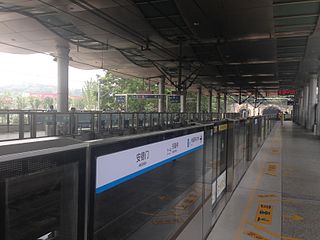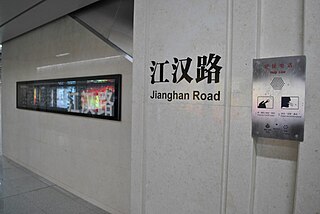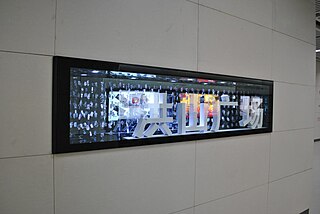
Zhengzhou Metro is a rapid transit rail network serving urban and suburban districts of Zhengzhou, the capital city of Henan province. It is operated by the state owned Zhengzhou Metro Group. As of November 2018, the network has 3 operational lines, with a network length of 93.7 kilometres (58.2 mi) and 59 stations. Opened on 26 December 2013, it is the first and currently the only operational metro system in Henan, and 18th in mainland China.

The Line 1 of Wuhan Metro is an elevated metro line in the city of Wuhan, Hubei. It is the longest continuous metro viaduct in the world. Line 1 opened on 28 July 2004, making Wuhan the fifth city in mainland China to have a metro system after Beijing, Tianjin, Shanghai, Guangzhou. This is the first Metro line in China wrongly referred to as a light rail line in Chinese terminology because it is elevated. Originally a branch line was planned to cross the Yangtze to Wuchang District via the Second Wuhan Yangtze River Bridge. The Second Wuhan River Bridge even had a provision in the central median where Line 1 trains would run in anticipation for the branch line when it opened in 1995. However by 2003 the reservation was removed to allow for more traffic lanes when the bridge was undergoing renovation.

The Line 2 of Wuhan Metro is the first underground metro line crossing the Yangtze River. This line has started trial run on September 25, 2012, and has opened on December 28, 2012. It is Wuhan's second metro line after Line 1, and the city's first underground line, since Line 1 is mostly elevated. Line 2 runs in a northwest-southeast direction, connecting Hankou and Wuchang, including Hankou Railway Station and major commercial districts.

The Line 4 of Wuhan Metro is the third line in Wuhan Metro system, and it will be the second metro line crossing the Yangtze river in Wuhan. It is colored grass-green, which is the identifying color of this line, which would appear on its trains, station signs, and the official subway map.

Jinmalu station is an interchange station between Line 2 and Line 4 of the Nanjing Metro. It is located to the north of Jinma Road and south of Benma Road (奔马路), parallel to Shishi Road (石狮路) in Qixia District. It started operations on 28 May 2010 along with the rest of Line 2; the interchange with Line 4 opened on 18 January 2017 along with the rest of that line.

Gulou station, is a interchange station on Line 1 and Line 4 of the Nanjing Metro. Opened on 3 September 2005 for the Line 1 portion of the station, Gulou station is among the first Nanjing Metro stations to open for passenger service. The line 4 section of the station opened on 18 January 2017, with cultural exhibits lining the station's walls. Located underneath a roundabout that links to Beijing West Road, Beijing East Road, Zhongyang Road, Zhongshan Road and Zhongshan North Road, Gulou station is located near Gulou Hospital, Nanjing University's Gulou campus, and is right underneath the Zifeng Tower.

Zhongsheng station is a railway station on Line 10 of the Nanjing Metro. When it began operations on 3 September 2005, it was part of Nanjing Metro Line 1's Phase I from Maigaoqiao to Olympic Stadium. On 1 July 2014, with the opening of Line 10, the former branch of Line 1 from Andemen to Olympic Stadium became re-designated as Line 10.

Andemen station, is a transfer station of Line 1 and Line 10 of the Nanjing Metro. It started operations on 3 September 2005 as part of Line 1's Phase I that ran north to Maigaoqiao; the previous branch of Line 1 from this station to Olympic Stadium was re-designated as Line 10 when that line opened on 1 July 2014, and Andemen became the eastern terminus of Line 10.

Daxinggong station, is an interchange station of Line 2 and Line 3 of the Nanjing Metro. It started operations on 28 May 2010 along with the rest of Line 2. The interchange with Line 3 opened along with the rest of that line on 1 April 2015.

Xunlimen Station is an interchange station between Line 1 and Line 2 of the Wuhan Metro. It entered revenue service along with the completion of Line 1 on July 28, 2004. The Line 2 platforms opened on December 28, 2012. It is located between Jianghan District and Jiangan District.

Jianghan Road Station, is an interchange station and Line 2 and Line 6 of the Wuhan Metro. It entered revenue service on December 28, 2012. It is located in Jianghan District.

Xiaoguishan Stationп, is a station of Line 2 of Wuhan Metro. It entered revenue service on December 28, 2012. It is located in Wuchang District. The previous name is South Tiyu Road Station.

Hongshan Square Station is a interchange station of Line 2 and Line 4 of Wuhan Metro. It entered revenue service on December 28, 2012. It is located in Wuchang District.

Yangjiawan Station, is an station of Line 2 of Wuhan Metro. It entered revenue service on December 28, 2012. It is located in Donghu New Technology Development Zone.

Optics Valley Square Station is an station of Line 2 of the Wuhan Metro. It served as the southeastern terminus of the line until February 19, 2019, when the extension of Line 2 to Fozuling opened. It entered revenue service on December 28, 2012. It is located in Donghu New Technology Development Zone. It is one of the busiest stations in the Wuhan Metro network serving 210,000 people on May 1, 2014. This station will be the interchange station of Line 2, Line 11 and Line 9.

Guangda station is a subway station in Changsha County, Changsha, Hunan, China, operated by the Changsha subway operator Changsha Metro.

Fuxing Road Station, is a transfer station of Line 4 and Line 5 of Wuhan Metro. It entered revenue service on December 28, 2014. It is located in Wuchang District.

Jimingsi station, is interchange station between Line 3 and Line 4 of the Nanjing Metro. It is named after Jiming Temple and also serves the Nanjing city government headquarters. It started operations on Line 3 on 1 April 2015, while the interchange with Line 4 opened along with the opening of that line on 18 January 2017.




































